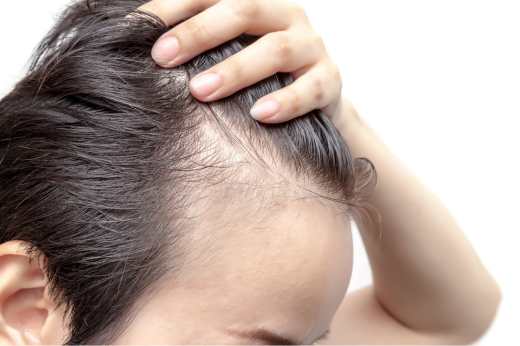
Alopecia Areata (AA) is an autoimmune disorder (your immune system attacks the healthy cells in your body) that causes hair loss. "Alopecia" means baldness, and "area" means patchy hair loss. It is a chronic (long-lasting) inflammatory disease that targets the hair follicles, damaging them. Even though, in many cases, hair loss can be extensive and unpredictable, it is not a contagious disease. AA affects people of all ages but commonly affects adolescents or young adults. Although it is not a very serious disease, it may cause anxiety among affected people.
To understand the types, causes, risk factors, symptoms, diagnosis, and treatment for alopecia areata, read on!
There are four main types of alopecia areata depending on the amount of hair loss.
In alopecia areata, your body's immune system attacks the hair follicles and disturbs normal hair formation for unknown reasons. This leads to abnormal hair loss, which may or may not regrow.
Certain risk factors may increase your likelihood of developing alopecia areata. These include:
Common symptoms of alopecia areata include:
Hair Loss
Nail Changes
Alopecia Areata is usually diagnosed by your dermatologist (a doctor specializing in diagnosing and treating conditions related to your skin, hair, and nails) through your symptoms and medical history.
However, the following additional tests may help in confirming the diagnosis:
Your dermatologist will grasp 40-60 closely grouped hair and apply a gentle grip. If more than 10% of hair is easily pulled out, then this test is considered positive
• Trichoscopy
This test involves an examination of the hair follicle, hair shaft, and scalp with a dermatoscope (a device used to examine the skin structures that are not visible through the naked eye).
The presence of yellow dots, small exclamation mark hair, and black dots (destroyed hair in the hair follicle opening) indicate alopecia areata.
• Skin Biopsy
This test involves removing a small piece of skin from the scalp and studying it under a microscope.
• Blood Tests
Blood tests are usually done to rule out other autoimmune disorders.
There is no cure for alopecia areata yet, but treatment helps focus on reducing symptoms, slowing down further hair loss, or helping the hair to grow back.
Treatment options include:
Topical Agents
These medications are rubbed against the scalp to stimulate hair growth. These include:
Injectables
These are solutions or medications injected near the areas of hair loss to stimulate hair growth. These include:
Oral Medicines
These are consumed as per the dose prescribed by the dermatologists. These include:
This therapy, also known as photochemotherapy, uses specific UV light wavelengths. Laser treatment delivers a specific radiation dose that encourages new hair growth by stimulating the hair follicles.
These treatments are all experimental and lack scientific evidence for their effectiveness. Consult your dermatologist before considering them.
Eating this diet reduces the body's immune response and further hair loss by decreasing inflammation. Blueberries, nuts, seeds, lean meat, beans, and broccoli are some examples.
You can reduce stress with the help of meditation, yoga, adequate sleep, relaxing by listening to music, connecting with other people, following a healthy lifestyle, and exercising.
Filling in eyebrows with makeup or a tattoo
Hair loss can be alarming and daunting. Alopecia Areata is a common autoimmune condition characterized by hair loss anywhere on your body, but more specifically, affecting your scalp. Moderate hair loss is common and considered a natural physiological hair growth process. But with alopecia areata, you may notice more hair loss than usual. This may cause an array of hair and nail changes that can lead to stress, anxiety, and depression. Reach out to your dermatologist as soon as you notice hair loss. Also, follow a healthy hair routine and avoid hair products with harmful toxins and chemicals that may damage them and further deteriorate alopecia areata.